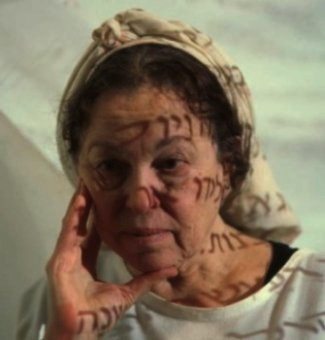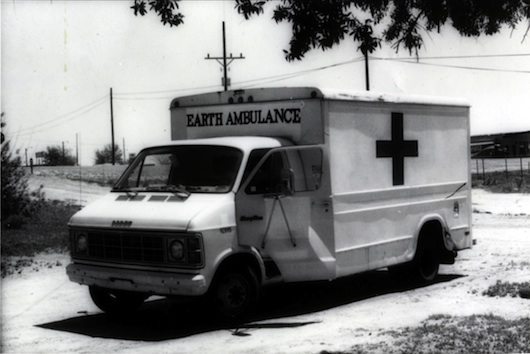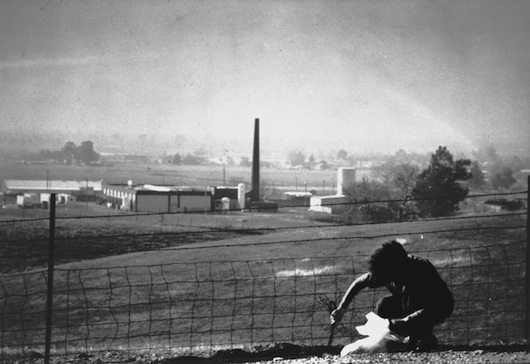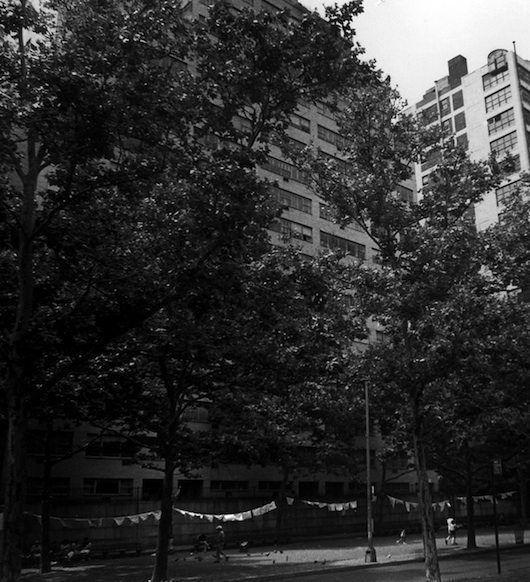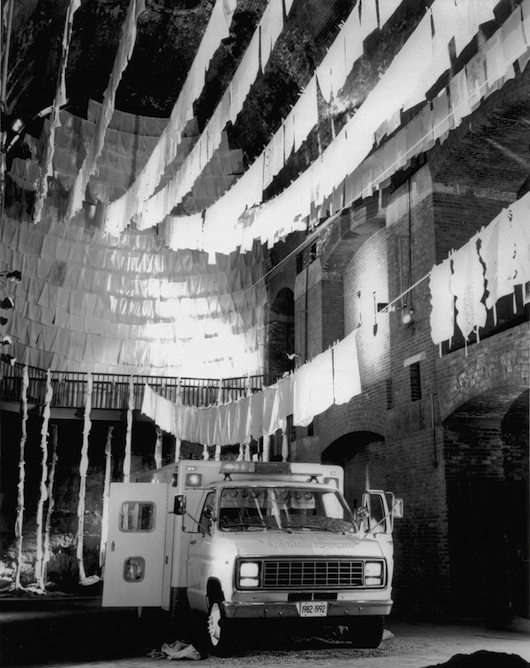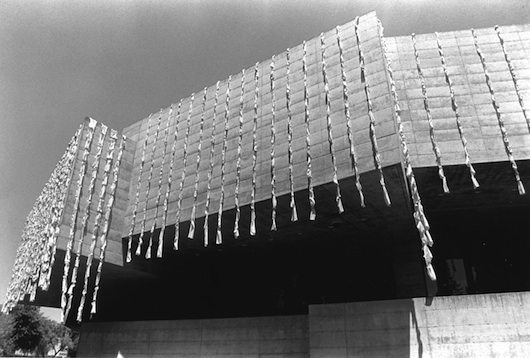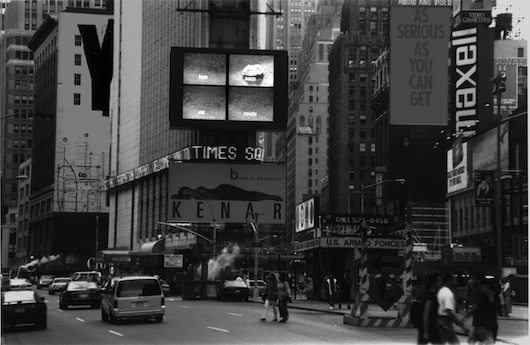In This Issue
-
Hiroko Shimizu ● Japanese Atomic Age Art: Ichi Ikeda Interview
-
Eve Andree Laramee ● Tracking Our Atomic Legacy
-
Beverly Naidus ● Nuked Notes: Free Radical Journey
-
Laura Lynch ● The Art Of Protest
-
Ann T. Rosenthal ● Infinity City: An Atomic Pilgrimage
-
Insa Winkler ● Missing Landscape – Chernobyl
-
Helene Aylon ● The Earth Ambulance
-
Cecile Pineda ● By Invitation Only
-
James Lerager ● A Photo Essay: Nuclear History, Nuclear Destiny
-
JL Malbrook ● Shifting Terrain
-
Susan Leibovitz Steinman ● ATOMIC LEGACY ART
-
Mary Jo Aagerstoun ● Anti-Nuke EcoArt
The S. A. C. /SAC VOYAGE OF THE EARTH AMBULANCE
EDITOR’S INTRODUCTION
WEAD IS PLEASED TO HONOR Heléne Aylon as Issue #5 Feature Artist. A dedicated peace eco-activist, staunch feminist and inspirational ritual performance artist, Helene has worked more than 40 years on conceptual artworks to ‘Rescue’ body, earth, spirit, and soon, civilization.
In the 1980’s-90’s, Aylon brought together hundreds (mostly women and nonartists) in large-scale performances of cooperation—notably including Arabs and Jewish women in Israel, Americans and Japanese in Japan, and in the former U.S.S.R., Americans and Soviets.
In the 60’s she started her art career as a cutting edge painter. In the 70’s—amidst rapidly changing politics and public interest art ideas, she emerged a first generation Feminist performance artist. Her performance art projects conceptually ‘rescued women’s bodies.’
Then in 1982 she was inspired by a talk she heard by Australian antinuclear activist Dr. Helen Caldicott. Concerned about the omnipresent threat of ‘nuclear shadow,’ she rededicated her artwork ‘To Rescue the Earth.’ For the next ten-plus years she created and directed one long series of expansive, inclusive, literally moving (physically, emotionally, aesthetically) international ritual performances called THE EARTH AMBULANCE. Deceptively simple, her ‘Rescue the Earth’ projects are based on developing opportunities for the international cooperation critical to planetary survival.
Here Heléne retells her intimate story of how THE EARTH AMBULANCE began.
I. EARTH AMBULANCE
THE AMORPHOUS IDEA TO “RESCUE” EARTH from S. A. C. (Strategic Air Command) military bases in pillowcases aka as “sacs,” popped into my brain as I opened my eyes one Berkeley CA morning in 1981. It was not long after hearing Dr. Helen Caldicott speaking at the university about the drastic need for disarmament and critical need to end the Cold War. Looking at news photos of refugees, there are always images of women fleeing with a “sac” of precious belongings in one hand, a child clasping the other hand. We, too, would take our most precious belonging— i.e. the Earth itself, in all its variety, in our “sac,” and carry it to safety.
Needing a pithy phrase to tell the message, I used the letters, S, A, and C to stand for “Survive And Continue” as opposed to “Strategic Air Command,” the symbol of our nightmares. I rented a truck, painted a large Red Cross sign on both sides and slapped the words Earth Ambulance on the front. Two of us would drive the ‘rescued’ earth in the ambulance, and others would follow in a borrowed white van. The refuge, naturally, had to be the United Nations.
Unbeknownst to me and the other women drawn to accompany me, this same instinct to face the military was compelling European women in large numbers to leave their homes to set up tents alongside American army bases in Greenham Common, England and in Comiso, Italy. This same instinct propelled American women to buy land adjacent to the Seneca Army depot in Romulus, New York, for confrontation and surveillance.
‘We will keep watch,’ was the idea. ‘We will point a camera. We will not flinch from peering through the fence eye to eye with those on the other side of the fence.’
I was no longer teaching painting and drawing at San Francisco State University. In the fall of 1981, I taught a course at the fledgling Feminist Institute in Berkeley. I titled the course, Performance Art as Anti – War Strategy.
I belonged to the Women’s Party for Survival, the San Francisco branch. This was the organization founded by Dr. Helen Caldicott. It was later renamed WAND, Women Against Nuclear Destruction. I presented the idea of the SAC/sac Caravan. They allowed me to put a blurb in their newsletter about my plan to go to the SAC bases. Faye Sellin, former Peace Corps worker, responded that she would help formulate an itinerary. Faye came to my tiny apartment in Oakland where we knelt on the linoleum kitchen floor, spreading out the War Resisters League’s map of Nuclear America.
“Look,” she said, “There are plenty of SAC bases all over. Which route do you want to take?”
II. MAPPING THE ROUTE
I lOOKED AT THE MAP. THE MAP HAD PINK spots all over it, like measles. These pink spots indicated areas subject to direct nuclear attack during a nuclear war by blast or heat or initial radiation. Some of these pink spots had little red arrows that indicated whether they were Strategic Air Command or submarine carrier bases or both. There were open stars for weapons research; colored stars for weapons stockpiles. An R meant military reactors. A ten-pointed star meant nuclear waste. A colored circle meant the reactor was operating, an open circle meant the reactor was being built, a green diamond meant nuclear fuel processing, an outlined diamond indicated a uranium – mining site.
My eyes began to blur.
“You might as well take the most scenic route,” Faye said. With that, she simply drew a straight line along the Pacific from Livermore SAC in the Bay Area to Vandenberg SAC in southern California. Then she moved her pencil to the right, landing at Kirtland SAC at the foot of the Grand Canyon. Once our journey was actually underway, Marie Fowler, a Native American woman, would join the Caravan at Four Corners AZ in a reservation known as Big Mountain, and introduce us to the Hopi and Dine (Navajo) lands. It became horrifyingly clear to us that the deadly nuclear cycle had its genesis in these ancient lands, now being raped for their uranium stores.
Faye quietly erased the straight line that dissected the country through the tip of Nevada, and, bypassing four little red SAC arrows, she drew a concave outline of a spoon that scooped down to Big Mountain in Arizona and ascended through New Mexico, passing through Kirtland SAC and on to Peterson SAC in Colorado Springs (the home of NORAD, the hollow mountain that we were told was a refuge for President Reagan in the event of a nuclear attack as though there could be a safe place.) Faye’s pencil swung upward to Rocky Flats plutonium trigger factory, one of the most dangerous toxic sites in the US. Then she looked up at me. “That’s scenic, all right.”
Faye wrote to other peace workers along this route to inform them that we were coming to “rescue” Earth from near their neighborhood SAC, and could they come to the nuclear military base with their pillowcases?
III. FINDING COMMUNITY
NOW IT WAS UP TO ME TO FIND OTHER women to join the Caravan. This would have been easier had we started after the school term was over at the end of June. But we had to get to New York City by June 12, 1982, the big day of the mass demonstration during the SALT talks at the United Nations (2). This meant leaving on the second day of May, as May 1st was a date too connected to other ideologies. Survival is apolitical.
Still, women came forth, for it was an idea whose time had come. Altogether, there were eleven women to begin the journey and two more joined in Albuquerque with their young daughters. In Wichita, Frieda Newman, a woman with cerebral palsy, was unable to articulate her emotions in words we could understand, but she drove with us from one SAC to another to dig the earth; Later we would learn that her brother died in Vietnam.
All told, our ages ranged from 4 to 51. Class, ethnic, educational backgrounds and abilities varied.
I designed a tallis Jewish prayer shawl for those who would be digging the earth to wear on their shoulders. A tallis is a large shawl worn by Jewish males when praying in the synagogue. Made of off-white linen with irregularly placed gray narrow and wider stripes, its significance is that all males are united whether wearing a Brooks Brothers suit or jeans beneath this cover. Our women’s tallis had one stripe of a repeated image of a double-knotted sac, silk-screened twelve times in a row, leaning to the left and to the right at various angles across the fabric.
Another 3 stripes of writing ran across the fabric in 3 rows:
Women’s sac Caravan
Departure – California 5/2/’82
Destination – New York, 6/12/’82, UN Disarmament Rally
Baggage – sacs of Earth from 12 S.A.C. weapons sites.
IV. DEPARTURE CEREMONY
THE LETTERS OF S A C, FOR STRATEGIC AIR COMMAND, were capitalized in Dick Tracy radiation-style letters; the lower case letters spelled our s a c, ‘survive and continue.’
Wearing this shawl, I spoke these words at the May 2, 1982 Sunrise Departure at Tilden Park in front of the Lawrence Berkeley Laboratories in the Berkeley hills:
Dear Friends,
This morning as the sun rises in the California sky, we open our windows in America. What do we see? We see arsenals in our backyards.
We are therefore starting on a voyage.
We will face twelve SAC bases across America, and point a finger and a camera. We will look eye to eye over the depot fences to those who guard the missile sites. We will write our unspoken nightmares onto our pillowcases that are bosom-soft with dreams. We will carry away the Earth in pillowcases, before the Earth gets contaminated. We do not cringe from the visionary. Adrienne Rich invokes our power to name: “In finding our own metaphors, we create a new culture.’
Our itinerary begins at Livermore Weapons Laboratory, CA; It continues to Vandenberg Air Force Base, CA; Los Alamos Laboratories, NM; Kirtland Weapons Storage, NM; Peterson Air Force Base, CO; Rocky Flats Plutonium Trigger Factory, CO; Leon Air Force Base, KS; McConnell Air Force Base, MI; We’ll visit the Missouri Nuclear Waste Burial, as children would come to play there; Whiteman Air Force Base, KS; Rickenbacker Air Force Base, OH; Bettis Atomic Weapons Laboratory, PA; We’ll visit Indian Point Nuclear Facility, NY and then proceed to our last stop, Piccatiny Warhead Design Arsenal, NJ.
We assemble here to bless this strange voyage to these twelve death plots that lie between two mighty oceans.
The Berkeley/Lawrence Laboratory is a fitting location for this Sunrise Departure ceremony. It is named after a scientist whose widow has requested that it be renamed: She has stated that Berkeley/Lawrence Laboratories, named after her late husband, Dr. Lawrence, had been known for its medical research, but was now tainted with its changeover to nuclear research. For this reason she no longer wanted her late husband’s name associated with the laboratory and the kind of research he detested. Thus far, the laboratory has ignored the request of the 85-year-old Mrs. Lawrence. By starting our voyage here, the wisdom of an elder’s request is no longer dismissed.
I wondered if I should whisper a Mi Sheberach, the prayer when doctors can no longer help. Still, the women jumped and clapped their hands and a group of runners ran in front of the Earth Ambulance as it inched down the steep hill.
Taking the back roads, we left the Berkeley hills to go straight to the Livermore Weapons Laboratory, where weapons are designed.
V. LIVERMORE WEAPONS LABORATORY
THERE ARE MANY BUILDINGS BUILT UPON the green. A few years hence, a wall will be built to hide these buildings; A few years hence, the adjacent green land will be purchased by the Military Complex to insure that a Women’s Encampment (such as the one that bought land near the Seneca Army Depot in Romulus, NY) will not engulf Livermore.
A year before the idea Earth Ambulance was born, I had come to Livermore to ‘rescue’ the Earth on my own; I actually was given permission from someone who worked at Livermore to dig some Earth nearby. That staff worker was ‘Big Al,’ who had gone to MIT with my son. Big Al, as he was affectionately called by his MIT buddies, chose the other route— to work here.
I asked at the desk to speak to him and stuttered this peculiar request, he good-naturedly though quizzically responded, ‘Anything for Nat’s Mother.”
I looked at Al, this young brilliant scientist and I wondered about him and all the other scientists in the grey buildings of Livermore, gobbled up from schools like MIT and Stanford University. There they were, poring over graphs and charts, concentrating on equations and diagrams, conferring on esoteric data under fluorescent lights. All in effort to come up with a “good” design for a weapon.
I began to wonder: Would this upcoming professional want to know if his theory worked?
Is a weapon designer curious about the outcome of his work in the same way that an analog photographer is curious to see how a print shows up from a promising negative?
Will a weapon desginer have pride in his work?
Will the weapon designer be the only one of all the professions to forfeit all sense of achievement?
VI. THE ‘RESCUED’ VOYAGE
DRIVING DOWN FROM LIVERMORE’S LOW – level waste burial, we passed Diablo Canyon, PG & E’s nuclear power reactor built on an earthquake fault where women who were arrested each gave the name Karen Silkwood (1).
We came to Vandenberg Air Force Base. There is the inland area with a huge parking lot, no place to dig. Two miles away there’s an area near the ocean spread out on a beach, with a special train that runs through the base. A sign by the tracks forbids photography. I shuddered to see the imprints of fat tire tracks in the sand.
It is said that Vandenberg is the home of the Trident nuclear submarine. I wondered if that meant inland or by the ocean. At any rate, the unseen Trident equipped with unseen missiles cost $1.7 billion.
We dug in the sand, our prayer shawls flapping in the ocean breeze like sea gulls.
VII. NEW YORK ANTI- NUCLEAR PROTEST
I HAD NAMED OUR VOYAGE TERRESTRI: ‘RESCUED’ EARTH and that is what we did until we came to New York in time for June 12, 1982, the day of the mass disarmament rally.
The pillowcases, scribed with dreams of peace and nightmares of war, were carried out on old army stretchers and emptied of their earthly contents into large shallow transparent boxes across the street from the United Nations at Ralph Bunche Park. The Isaiah Wall was in the background, with words about the lion lying down with the lamb.
The eight foot frames of various earths appeared as a painterly installation with different colors, textures, and moisture contents, evoking their far-flung origins — the condensation on the inside of the lids of the individual boxes fogging and re-clarifying the image of the earth within.
Placing the different earths in art frames, they appeared as rare, precious works of art to be reflected upon, handled with care, preserved, restored, minutely observed like works in an exhibition. In seeing the beauty, the viewer can imagine the horror. Aesthetics can penetrate the numbness that besets the psyche when issues are too horrendous to scrutinize.
POSTSCRIPT
IN 1995, CURRENT: TWO SACS EN ROUTE AND Bridge of Knots were shown as a bi-coastal commemoration for the 50th Anniversary of Hiroshima and Nagasaki.
In California, the river voyage of the sacs was screened at the Pacific Film Archives of the Berkeley Art Museum while Bridge of Knots hung on the Museum’s facade.
In 2004 Bridge of Knots 1 (the initial pillowcases from the cross country sac/SAC voyage) was acquired by the Hudson Valley Center for Contemporary Art in Peekskill and hung with the installation of the Earth Ambulance ’82-’92- ’02. This Earth Ambulance contained blank pillowcases (as a Tabula Rasa). The surrounding pillowcases that were stained with rain and earth and wrinkled and torn contrasted with the blank sterile starched white pillowcases of the future that we do not know as yet.
In 1992 I showed the Earth Ambulance at Creative Time under the Brooklyn Bridge anchorage. At the end of the show, I declared a celebration for the end of the Cold War.
After all, Gorbechov just stated “never mind.” Perhaps that’s all it takes, from a leader of a government. No need to keep spending millions on “deterrence.”
The pillowcases were hung on the facade of three museums. In 1995, they hung on the Berkeley Art Museum for the bi-coastal commemoration of the 50th anniversary of the atomic tragedies in Hiroshima and Nagasaki.
I went to Japan in 1985 for the 40th year commemoration of these tragedies. I asked the Hibakushas (survivors of the A bomb) to write their own messages on their own pillowcases in their own homes. In a kinetic performance, I floated two sacs on the waters of Japan en route to these cities. Students from Seika College put resuscitative seeds into the sacs as a symbol of rebirth.
Art critic Peter Selz reviewed this installation in Art in America:
Heléne Aylon at the University Art Museum:
Not only was the University of California at Berkeley a center of the anti-war movement in the ’60s and ’70s, but it was more recently the bailiwick of I.
Michael Heyman, who served as chancellor at the university for a decade, left in 1990 to become the new secretary of the Smithsonian Institution. It was Heyman who capitulated to right-wing pressure and agreed to bowdlerize the National Air and Space Museum’s Enola Gay exhibition, which was to have been a scholarly reassessment of the use of the bomb. Heyman is also reported to have obtained the resignation of the museum’s director, Martin Harwitt. It seems proper, somehow, that an art event questioning the morality of the 1945 devastation should take place at Heyman’s former campus.
In NYC, a two-minute clip of the video of the 1985 River journey was screened hourly in 1995 on August 6th, Hiroshima Day and August 9th, Nagasaki Day on the Times Square Jumbotron. The question is posed to the hurrying passersby carrying an attaché case who might take a second to look up at the screen: ‘What would you take, what would you carry in your sac?’
(I wonder why there’s such a hullabaloo about New Year’s Eve in Times Square every December 31st. What if these two sacs could be shown on Times Square on Hiroshima Day to raise sober consciousness about the nuclear threat?)
END NOTES:
(1) http://en.wikipedia.org/wiki/Karen_Silkwood
(2) http://www.armscontrol.org/documents/salt
http://en.wikipedia.org/wiki/Strategic_Arms_Limitation_Talks

